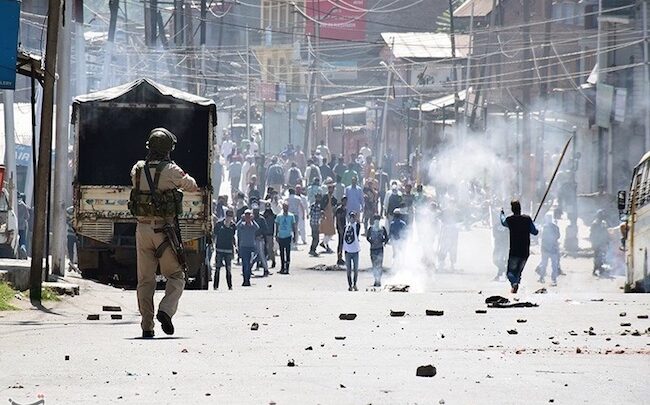As Kashmir simmers the IOR too stands as a potential nuclear flashpoint

This year has seen tensions between Nuclear armed Pakistan and India reach unprecedented levels with both countries flirting with a dangerous escalation spiral. February’s aerial engagement between the two countries’ air forces, sustained exchanges of small arms and artillery fire over the LOC, as well as the ongoing curfew and communications blackout (now in its 100th day) have all left many to contemplate the long-term consequences of these altercations on the stability and overall security of the entire South Asian region.
These include consequences leading to as far as the Indian Ocean Region, which despite being more than 1300kms away from the LOC remains witness to a series of dangerous developments, especially within context of the current scenario. For instance, India’s recently planned test of its K4 Submarine Launched Ballistic Missile (SLBM) represents a key part of India’s long-held desires of developing a robust second-strike capability. While the test itself is meant to signal a major tipping point within the overall strategic balance of the region, the worsening situation in Kashmir carries the risk of unnecessarily heightening tensions at a time when the regional situation is already quite complex. This is largely because the K4 with its purported range of 3500 kms is capable of targeting most of mainland China in addition to Pakistan from the relatively safer distance of India’s coastal waters. Its value as a strategic deterrent is evident from its planned deployment on India’s nascent fleet of nuclear-powered ballistic missile submarines (SSBNs). These include the INS Arihant and the recently commissioned INS Arighant for which the K4 has been designed to spec. With the Indian navy planning to induct even more SSBNS over the next decade, there are soon likely to be dozens of K4 missiles deployed on these subs, which themselves are likely to remain scattered across the IOR.
While the planned deployment of these missiles was to supposedly herald India’s coming of age as a major global power, the current context in which these actions are being taken presents a troubling scenario. Particularly keeping in mind the apparent shifts in India’s nuclear doctrinal and policy framework, the very thought of such nuclear weapons being readily deployed across the Indian Ocean represents a major cause for concern the world over. Unlike India’s land-based nuclear arsenal where its nuclear warheads are largely demated from the several delivery systems available to its military, India’s sea based nuclear arsenal is likely to be deployed at a much more heightened state of alert. As a result, it is also likely to be subject to an altered or more sophisticated command and control structure which in itself requires seamless communications not only between the Indian state and military but also within the many arms of the Indian military itself. Such integration is further conditional on India acquiring highly robust intelligence, surveillance and reconnaissance (ISR) capabilities that leave absolutely no margin for error considering the immense risks at stake in one of the world’s most volatile regions. Add to that the Indian government’s now institutionalized approach to nuclear brinkmanship and its steady revocation of its ‘No First Use’ policy, there exists a highly dangerous mix of hubris and recklessness where the entire human race risks being annihilated from even the smallest of missteps.
While some may argue that India is still quite a few years away from deploying a notable fleet of SSBNs armed with its K4 SLBMs, the nuclear weapons already deployed by the Indian Navy already pose quite serious challenges to regional stability. In addition to the K4 which is still under testing, India has equipped several of its surface and sub-surface platforms with a number of other nuclear capable missiles such as the Dhanush and the K-15 Sagarika SLMBs. Considering their relatively short ranges (the Dhanush has a target range of 350kms, while the K-15’s range is around 750-800 kms) these weapons are unlikely to be able provide an adequate second-strike deterrent. However, being mostly Pakistan specific, they still contribute immensely to converting the entire Indian Ocean Region to a nuclear flashpoint in addition to the LOC.
In fact, considering the direction in which India’s military thinking has evolved over the last decade, the IOR’s potential as a nuclear flashpoint is arguably even greater than that of the LOC. The sea’s vastness, lack of terrestrial boundaries and potential lack of collateral damage makes a nuclear detonation in the IOR all the more likely. This can range from a non-targeted nuclear detonation as a mere show of force to a tactical nuclear strike on a specific naval platform and its crew in a bid to achieve escalation dominance early on in a conflict. As has often been the case with Indian military thinking, such a scenario can arise from a gross overestimation of its capabilities. Derived from its conventional military superiority (which is already more manifest at sea), such conditions make for an attractive option for India to conduct a limited war against Pakistan at sea.
However, considering how both the Indian and Pakistani navies have opted to commingle conventional and nuclear weapons across a large section of their naval platforms, the risks of any conventional engagement escalating to the use of nuclear weapons remain unacceptably high. As such, even thinking that escalation from a small engagement or skirmish at sea can be managed by either side is downright illusory at best. Yet, based on the Indian state’s most recent actions and statements, whether the hubris coming out of India’s leaders extends to the manic delusions of a winnable nuclear war is unnervingly open to question.
One hopes that the world never has to contemplate, let alone face, the consequences of such an appalling possibility.




